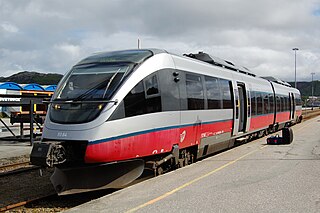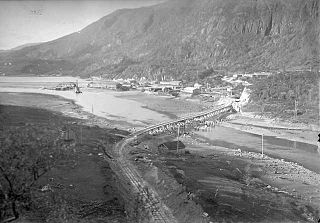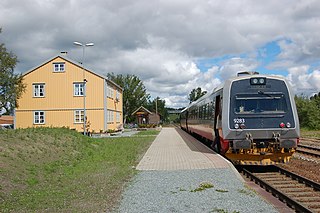The Airport Express Train is a Norwegian high-speed airport railway service connecting Oslo Airport to Oslo Central Station in nineteen minutes. Run by Flytoget AS, it operates on the high-speed Gardermoen Line using sixteen GMB Class 71 electric trains. Normal service frequency is once every ten minutes, with five of the services each hour continuing westwards beyond Oslo Central. The extended services serve nine stops within Greater Oslo and take up to 60 minutes.
The signalling system used on the rail transport in Norway is regulated by the Regulations of December 4, 2001 no. 1336 about signals and signs on the state's railway network and connected private tracks.

The Nordland Line is a 729-kilometer (453 mi) railway line between Trondheim and Bodø, Norway. It is the longest in Norway and lacks electrification. The route runs through the counties of Trøndelag and Nordland, carrying a combination of commuter, long-haul passenger and freight trains. From Trondheim Central Station to Steinkjer Station the line is most heavily used, with hourly services by the Trøndelag Commuter Rail. There are three branch lines—the Stavne–Leangen Line at Leangen Station, the Meråker Line at Hell Station and the Namsos Line at Grong Station.
Linx AB was a railway company which operated inter-Scandinavian passenger trains between 2001 and 2004. Established as a joint venture between the Norwegian State Railways (NSB) and the Swedish state-owned SJ, Linx operated the routes from Oslo, Norway, to Stockholm, Sweden, and from Oslo via Gothenburg, Sweden, to Copenhagen, Denmark. Services were provided up to ten times per day. However, slow speeds caused by curvy infrastructure in Norway, combined with competition from low-cost airlines, caused the company to lose money, and eventually grounded operations. The services were taken over by NSB and SJ. The main rolling stock were eleven X2 electric multiple units, although it used SJ Rc-hauled trains on the Gothenburg–Oslo service. The company was based in Gothenburg.

Nazi concentration camps in Norway were concentration camps or prisons in Norway established or taken over by the Quisling regime and Nazi German authorities during the German occupation of Norway that began on 9 April 1940 and used for internment of persons by the Nazi authorities. 709 prison camps or concentration camps, [including some death camps,] were counted by a project that had Randi Bratteli, as an advisor. Another source has claimed that there were around 620 prison camps.

The Ofoten Line is a 43-kilometre (27 mi) railway line in Narvik, Norway. It runs from the Port of Narvik to Riksgränsen on the Norway–Sweden border, where the line continues as the Ore Line via Kiruna and Gällivare to Luleå. The Ofoten Line is single track, electrified at 15 kV 16.7 Hz AC and has seven stations. The line only connects to the rest of the Norwegian railway network via Sweden. The main traffic is up to 12 daily freight trains operated by Malmtrafik that haul iron ore from Sweden to Narvik. In addition, CargoNet operates container trains, branded as the Arctic Rail Express (ARE), and Vy Tåg operates passenger trains, including a night train to Stockholm.

Class 93 is a tilting two-carriage diesel multiple unit used by SJ Norge for passenger trains on non-electrified stretches of the Norwegian railway network. Used on the Nordland Line, the Røros Line and the Rauma Line, they were purchased to replace the aging Di 3 locomotive-hauled trains. The Class 93 was produced by Bombardier, and is part of the Talent family. Fifteen units were delivered between 2000 and 2002.

Norske tog Class 92 is a class of 15 diesel multiple units built by Duewag for the Norwegian State Railways (NSB). The two-car trains were delivered in 1984 and 1985, and were put into service on the Røros Line and southern part of the Nordland Line—which later became the Trøndelag Commuter Rail. Later, they also entered service on the Meråker Line as part of the international Mittnabotåget service. Previously, the trains were also used on the Solør Line, further north on the Nordland Line and on the now electrified Arendal Line. In 2000, a unit was involved in the Åsta accident; which killed 19 people. The trains were refurbished in 2005 and 2006, and NSB plans to replace them by around 2019. Each twin unit seats 168 people, is 49.45 meters long and weighs 92 tonnes. The front car is powered with two electric motors, giving a power output of 714 kilowatts (957 hp) and a maximum speed of 140 kilometers per hour (87 mph).

The NSB Di 8 is a class of diesel-electric locomotives built by Maschinenbau Kiel (MaK), while it was part of Siemens Schienenfahrzeugtechnik, for the Norwegian State Railways (NSB). The locomotives are equipped with a Caterpillar 3516 DI-TA prime mover, which provides a power output of 1,570 kilowatts (2,110 hp) and a starting tractive effort of 270 kilonewtons (61,000 lbf).

The Iron Ore Line is a 398-kilometre (247 mi) long railway line between Riksgränsen and Boden in Norrbotten County, Sweden, owned by Trafikverket. The line also contains two branches, from Kiruna to Svappavaara and from Gällivare to Koskullskulle. The term is often colloquially used to also include the Ofoten Line, from Riksgränsen to Narvik in Norway, and the northernmost part of the Main Line Through Upper Norrland from Boden to Luleå. The railway from Narvik to Luleå is 473 kilometres (294 mi) long.
Ofotbanen Drift AS, trading as Ofotbanen, was a Norwegian passenger and freight railway company. The company operated a fleet of six locomotives, three multiple units, 22 passenger and 48 freight cars. The sole service was the passenger train Unionsexpressen between Oslo and Stockholm; it had previously offered freight haulage on contract.

The Polar Line is an incomplete and abandoned railway line in Norway, from Fauske to Narvik and, if finished, ultimately would have run 1,215 km (755 mi) to Kirkenes.

The Hell–Sunnan Line is a 105-kilometer-long (65 mi) railway line between Hell, Stjørdal and Sunnan, Steinkjer in Nord-Trøndelag, Norway. The name is no longer in official use and the line is now considered part of the Nordland Line. The Hell–Sunnan Line branches from the Meråker Line at Hell and runs on the east shore of the Trondheimsfjord passing through the municipalities of Stjørdal, Levanger, Verdal, Inderøy and Steinkjer.

The German occupation of Norway began on 9 April 1940. In 1942, there were at least 2,173 Jews in Norway. At least 775 of them were arrested, detained and/or deported. More than half of the Norwegians who died in camps in Germany were Jews. 742 Jews were murdered in the camps and 23 Jews died as a result of extrajudicial execution, murder and suicide during the war, bringing the total of Jewish Norwegian dead to at least 765, comprising 230 complete households.
Elisenberg station is an unfinished railway station within the Oslo Tunnel on the Drammen Line in Oslo, Norway. The ghost station was partially built during the construction of the tunnel between 1971 and 1980, but has never been put into use. It is located between Nationaltheatret Station and Skøyen Station, at Elisenberg in Frogner. A 220-meter (720 ft) long center platform and part of the access way has been built, but never completed. While the station initially was not put into use because of lack of funds to complete it, it is now unlikely that it will ever be completed, as the need for a station has disappeared and an opening would need a large investment of funds.
The Osvald Group was a Norwegian organisation that was the most active World War II resistance group in Norway from 1941 to the summer of 1944. Numbering more than 200 members, it committed at least 110 acts of sabotage against Nazi occupying forces and the collaborationist government of Vidkun Quisling. The organisation is perhaps best known for conducting the first act of resistance against the German occupation of Norway, when on 2 February 1942, it detonated a bomb at Oslo East Station in protest against Quisling's inauguration as Minister-President.
Kjeld Rimberg is a Norwegian businessperson.

Bjørn Petter Westlie is a Norwegian journalist, historian, university college lecturer and non-fiction writer.
Lenin's Kisses is a novel by the Chinese writer Yan Lianke, published in 2004.

The Beisfjord massacre was a massacre on 18 July 1942 at Beisfjord Camp No.1 in Beisfjord, Norway of 288 political prisoners. The massacre had been ordered a few days earlier by Josef Terboven, the Reichskommissar for Nazi-occupied Norway.













